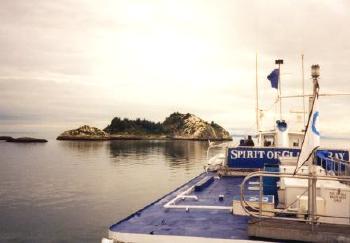Glacier Bay: Hoonah–Angoon Census Area Census Area of the Unorganized Borough, Alaska, USA (August 1995)

South Marble Island (map) is a small protrusion within the main channel of Glacier Bay as one sails from the Visitors Center at Glacier Bay National Park up towards the major glaciers. It would be unremarkable except that it houses a notable and important colony for the pigeon guillemot (Cepphus columba), a north pacific seabird. These black birds have white upper wing patches marked by a black triangle, along with distinctive red legs. Guillemots nest within the island’s rocky crevices.

Steller sea lions (Eumetopias jubatus) also use South Marble Island as a haul-out location. This photograph shows one place where this happens. If you look closely you may be able to see some of them. Steller sea lions are the largest of the eared seals. They got their name from George Wilhelm Steller, a German naturalist that participated in the 1741 Bering expedition. He scientifically classified them first so he named them for himself.

Federal laws protect Steller Sea lions. Guillemot need undisturbed locations for breeding. Therefore, humans cannot visit South Marble Island. The National Park Service maintains strict rules requiring people to stay clear.
See the article index from the 1995 Southeast Alaska trip.

Leave a Reply